This beautiful lemon and elderflower cake is made for special occasions and big celebrations! Three layers of light and fragrant sponge flavoured with lemon and elderflower and filled with fluffy elderflower buttercream and sweet and tangy lemon curd. The cake is finished with an elegant, white chocolate ganache drip for an eye-catching and very memorable bake!
You can prepare each component of this show-stopping elderflower cake at least a day in advance, making the assembly and decoration a much easier and quicker process.

If summer was a cake, it will definitely be this lemon and elderflower cake! Elegant, light and moist, with floral notes and fragrant flavours. No surprise it was the royal wedding cake, as it truly is a royal treat!
When I think of a cake for a really special occasion like big birthdays, weddings or anniversaries, this elderflower cake, along with my Fraisier Cake, are always the first ones to come to mind. If these bakes seem to be a bit too fancy for your liking, I have plenty of other options available in my Cake recipes category.
Jump to:
Ingredients and substitutions
Let's split the ingredients into two groups: the sponge and the filling (including the syrup and decoration). Here's what you will need to make the sponge cakes:

- Butter - Ideally, use the unsalted butter in all of this recipe. Unsalted butter in baking allows the real, natural flavours of the ingredients to come through much better. Salted butter will work, but the flavour of the finished cake may be just slightly different. Alternatively, use baking spread like Stork instead.
- Sugar - White caster sugar will work best, as it has the superfine texture. You can also use granulated sugar, or golden sugar instead.
- Eggs - We are using medium eggs in this recipe. Be sure to have them at room temperature before using.
- Soured cream - To make the cake moist and rich. Use the natural full-fat yoghurt as an alternative.
- Elderflower cordial - I'm using my homemade classic elderflower cordial. You can also use shop-bought cordial, which is widely available in most supermarkets.
- Flour - This lemon cake is made with self-raising flour, which already has the baking powder added to it. Check out the recipe notes for the alternative on how to make your own self-raising flour.
- Lemon - We are using lemon zest for the sponges and the juice for the syrup.
To make the buttercream and the white chocolate ganache drip you will need the following items:

- Butter - Same as above, try using the unsalted, room temperature butter.
- Icing sugar.
- Elderflower cordial - See above.
- Lemon curd - I'm using my homemade lemon curd in the filling, but feel free to use shop-bought curd. Alternatively, you could also use jam. Blackcurrant or blackberry jam will work particularly well here.
- White chocolate - Use a good quality white chocolate. It really makes a difference!
- Double cream.
Instructions
Let's start with the sponges. Have the cake sandwich tins lightly greased and lined with the baking paper and set them aside.

Cream the softened butter and the sugar together until pale and fluffy.
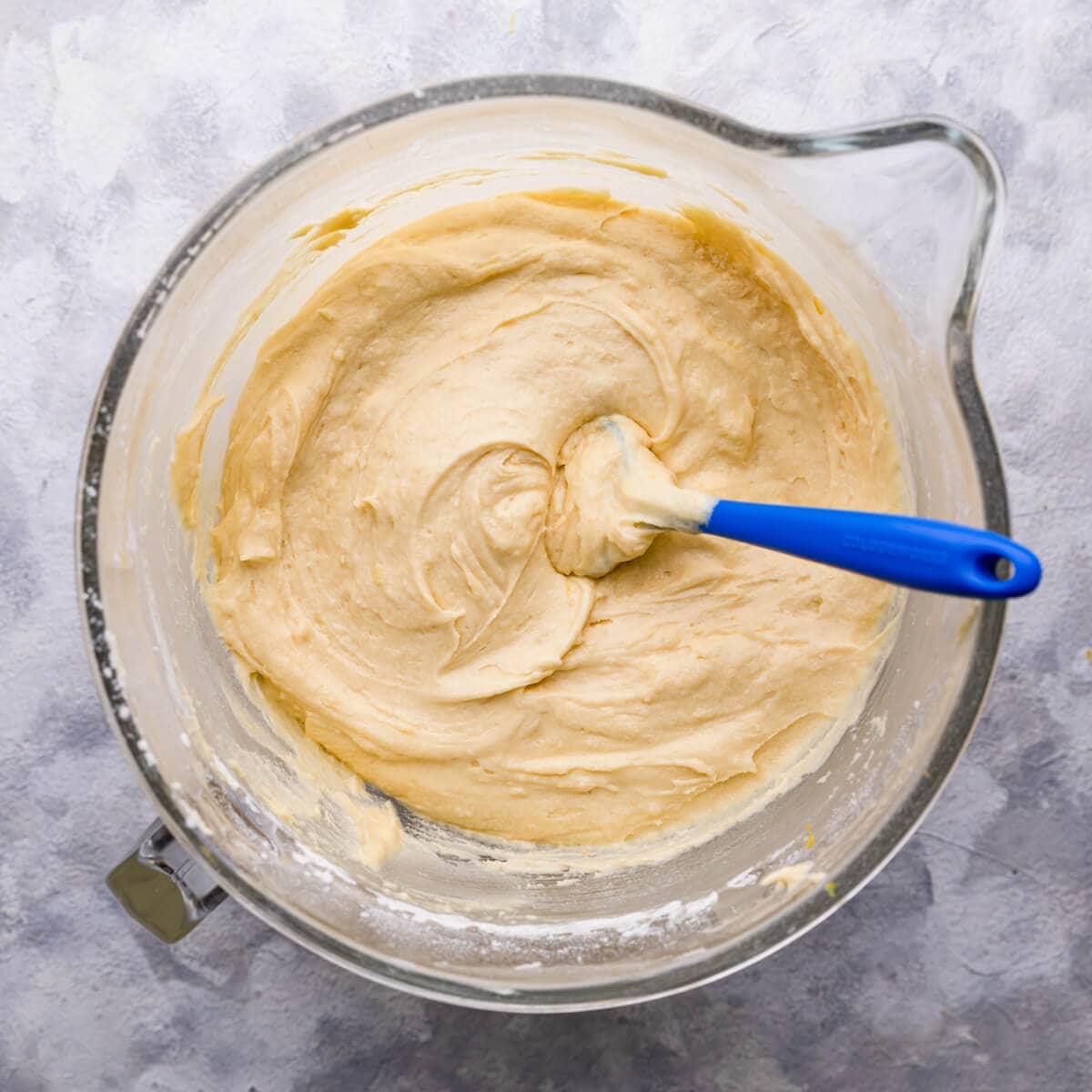
Add the wet ingredients followed by flour and combine well.

Divide the batter between cake tins and bake for 35-40 minutes.

Remove from the oven and allow the sponges to cool completely.
Hint: Use the digital kitchen scales to divide the cake batter precisely between the cake tins, or use an ice cream scoop as an alternative.
As the sponges are cooling down, prepare the syrup, buttercream and the white chocolate ganache.
White chocolate ganache
While making the syrup and the buttercream are very straightforward, the white chocolate ganache can be a little more tricky.
Because white chocolate ganache doesn't firm up as well as dark chocolate, I always replace the small quantity of cream with butter.
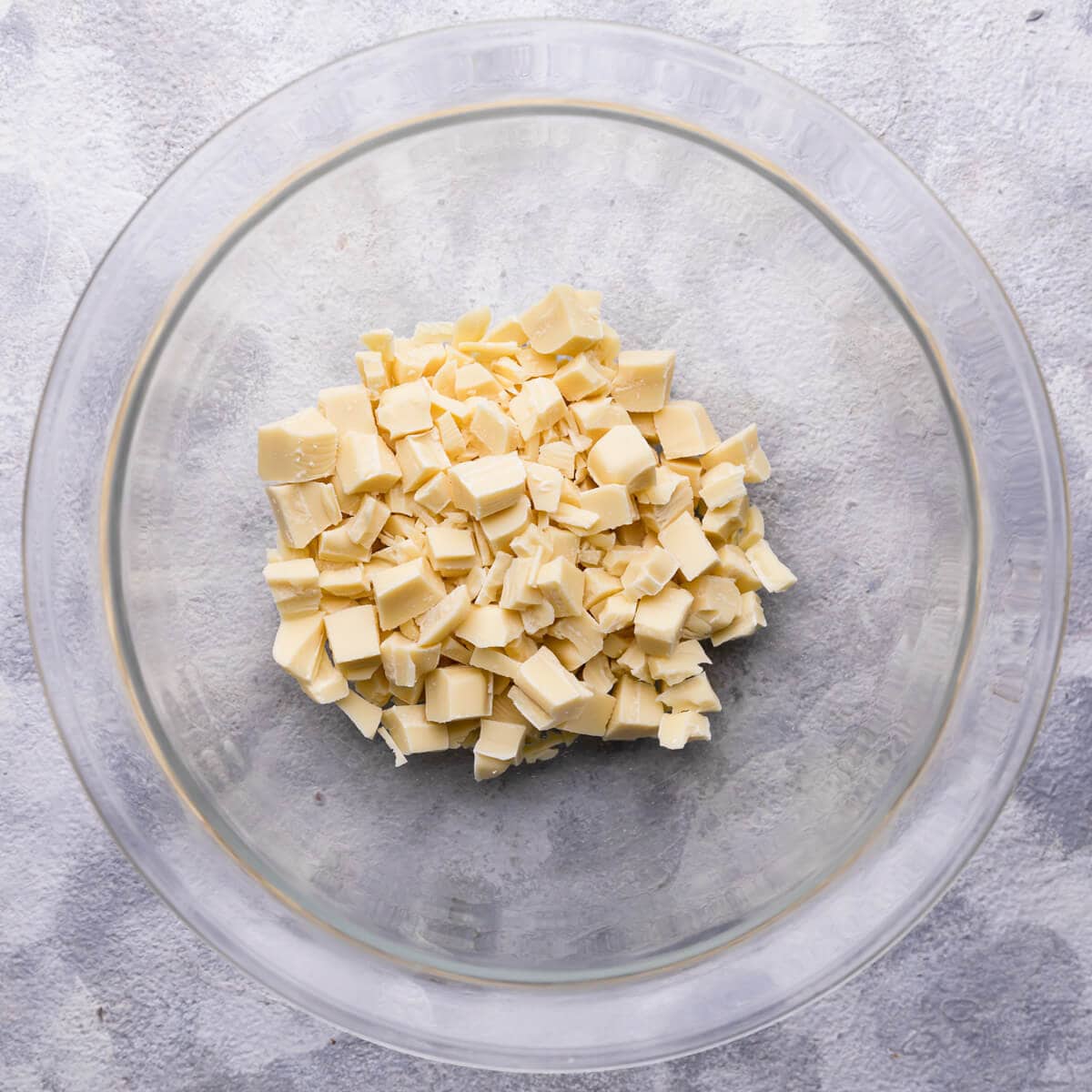
Place finely chopped white chocolate in the heatproof bowl.

Slowly pour the hot cream and melted butter over the chocolate and let it sit for a couple of minutes. DO NOT STIR.

After a couple of minutes, stir it gently until chocolate is melted and you have smooth and shiny ganache.

Leave the ganache to cool and thicken, then stir gently, but don't overbeat or it will separate.
If the ganache is to be used to cover the cake, then you can pour the still liquid ganache over it. To use it as a spread or filling or if piping the drip, leave it to thicken until it's firm enough to hold its shape.
Hint: If the ganache gets too firm, it can be gently warmed in a bowl set over a pan of warm water. Do not overheat it or the mixture will seize up.
Cake assembly
Once you have the sponges, syrup, buttercream and ganache ready, it is time to assemble the cake layers. Use a large serrated knife or cake leveller to slice the top of each sponge to level them up (if needed).
Having the cake turntable is very helpful during this process, especially when covering the cake with the buttercream, but it is not necessary to have one. Also, trimming the sponges is totally optional here.
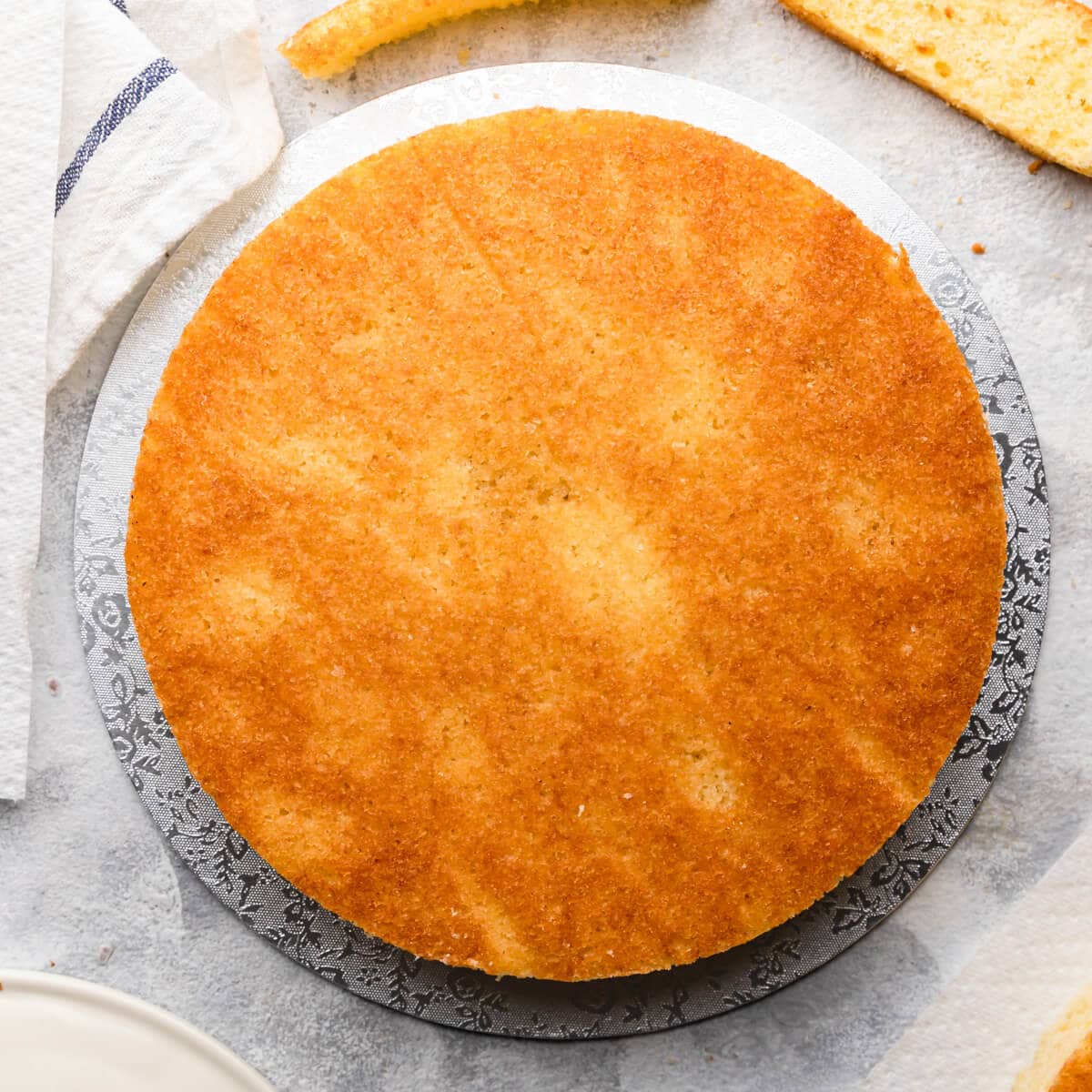
Trim the cooled sponges around the edges (optional). Use smaller plate or a cake board as a guide if you'd like. Brush the sponges with the syrup.

Place the first sponge onto the plate or cake turntable and pipe the layer of buttercream on top.

Add a layer of lemon curd on top of the buttercream and spread evenly. Add the second sponge and repeat with the filling, finishing off with third sponge on top.

Crumb-coat the cake and chill for about an hour.
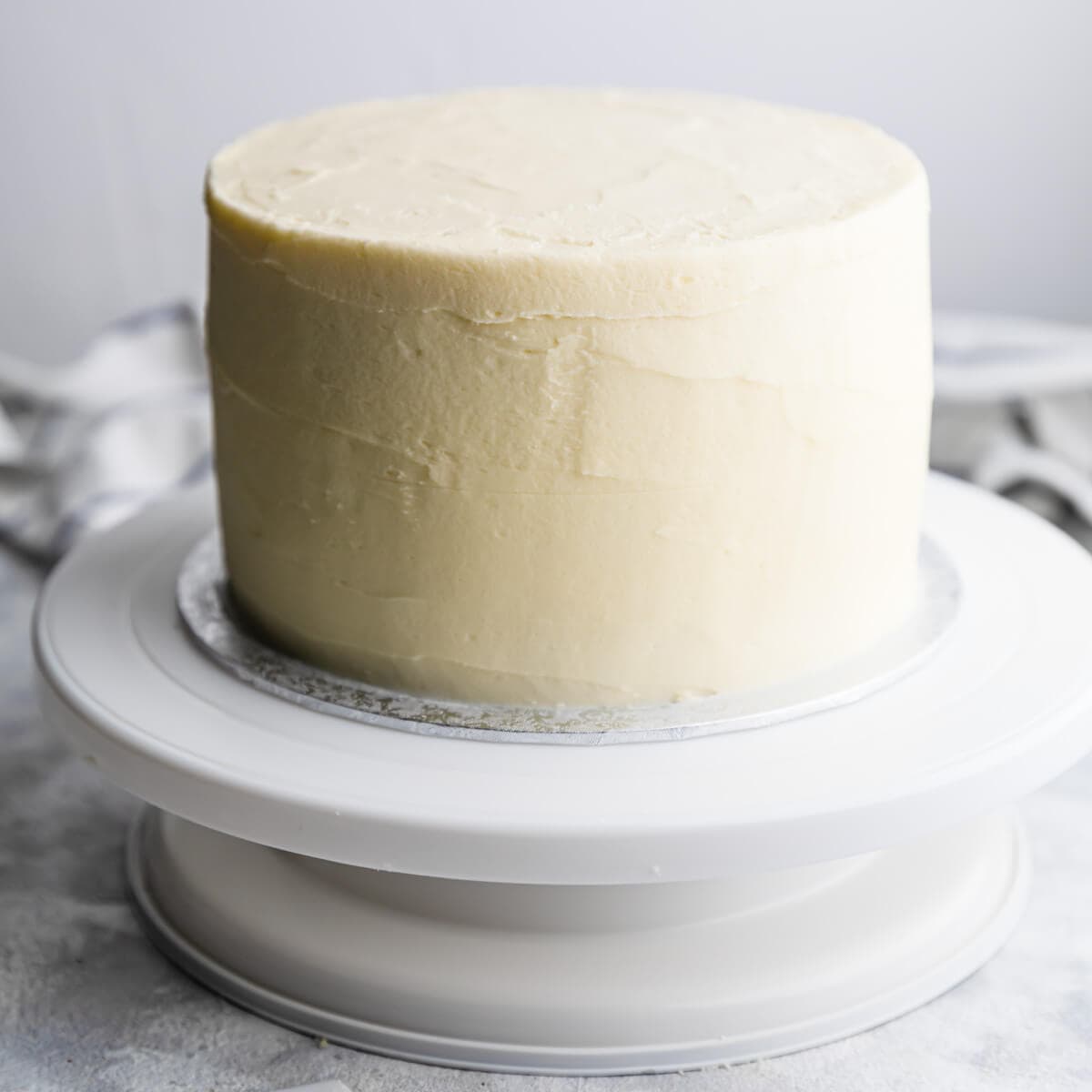
Cover the cake with buttercream and smooth out the edges and the top using palette knife or cake scraper.
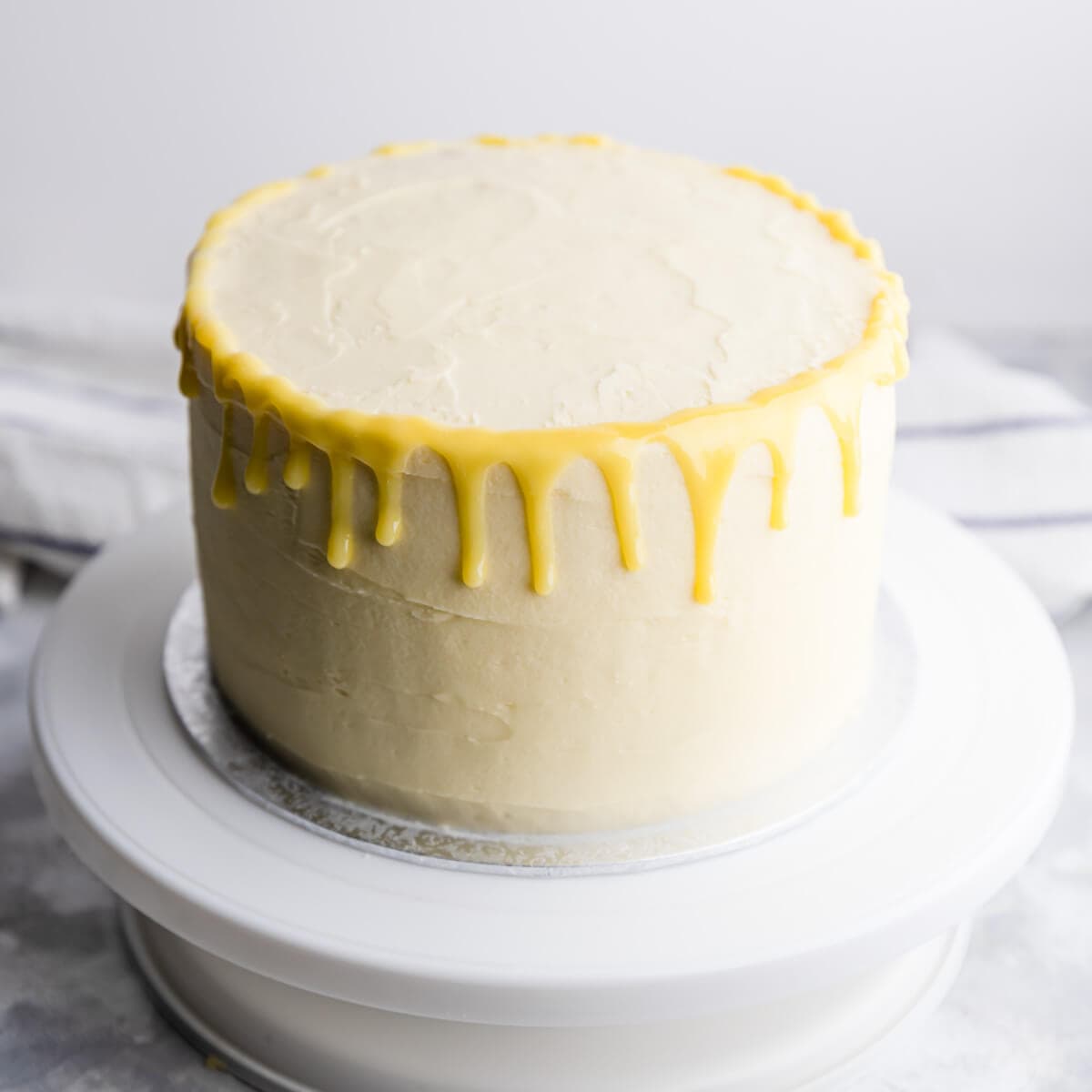
Pipe the white chocolate ganache. Decorate the cake with any remaining buttercream and your choice of decorations.
If you are looking for a helpful video tutorial on how to decorate the cake with buttercream, I recommend watching this YouTube video from Cupcake Jemma.
Make ahead
This lemon elderflower cake recipe is a perfect recipe to make ahead. If you prepare the sponges and buttercream a day or two in advance, the whole process is much quicker and easier to manage.
- Sponges - Bake in advance and store in the fridge for up to 3 days. Make sure to wrap them in a double layer of cling film to prevent them from drying out.
- Syrup - Make it a day or two ahead and store in the fridge.
- Buttercream - Just like the sponges, you can make the buttercream up to 3 days ahead. Keep it in the airtight container in the fridge. Bring it to room temperature before using and whip it up again for a minute or two.
- White chocolate ganache - You can prepare the ganache up to 3 days before and store it at room temperature.
The time required to assemble the cake will depend on your experience. Allow yourself anywhere between 30 minutes to 1 hour to put it all together.
Variations
Here are few ideas on how you can try different variations of this elderflower lemon cake:
- Different filling - Use raspberry, blackberry or blackcurrant jam instead of lemon curd in the cake filling. Sharp, tart flavours will work exceptionally well with the sweet buttercream.
- Buttercream - If you would like to try different type of buttercream, Swiss meringue buttercream will be the one to go for. You make it by beating the egg whites and sugar together in a double boiler, and it has super-smooth and dense consistency. For the more experienced bakers, Italian meringue buttercream could also be an option (check out my Lemon Meringue Pie recipe to see how to make Italian meringue)
- Syrup - Enhance the elderflower flavour by adding a tablespoon of elderflower syrup or elderflower liqueur to the syrup together with the lemon juice.
- White chocolate ganache - You can replace it with any type of chocolate if you prefer, or even skip it all together.

Equipment
- Handheld electric mixer or freestanding mixer with paddle attachment.
- Cake sandwich tins - Use 3 20cm (8") cake tins in this recipe.
- Baking paper - For lining the cake tins with.
- Kitchen scales - Optional, but helpful for dividing the cake batter precisely between the cake tins.
- Piping bags - For the buttercream and for the chocolate ganache. Alternatively, you can also use a squeezy bottle to pipe the white chocolate ganache around the cake.
- Cake turntable - Optional, but really helpful when icing the cake.
- Palette knife or cake scraper - For applying the buttercream and smoothing the buttercream.
Storage and freezing
Store any leftovers of this cake at room temperature for up to 24 hours, or in the fridge for up to 3 days. You can keep it in the cake caddy or a large cake container. You can also freeze any leftovers for up to two months. Thaw them in the fridge overnight.
Although you can freeze the whole cake (with the buttercream and the filling), it can be tricky, considering the size of the cake.
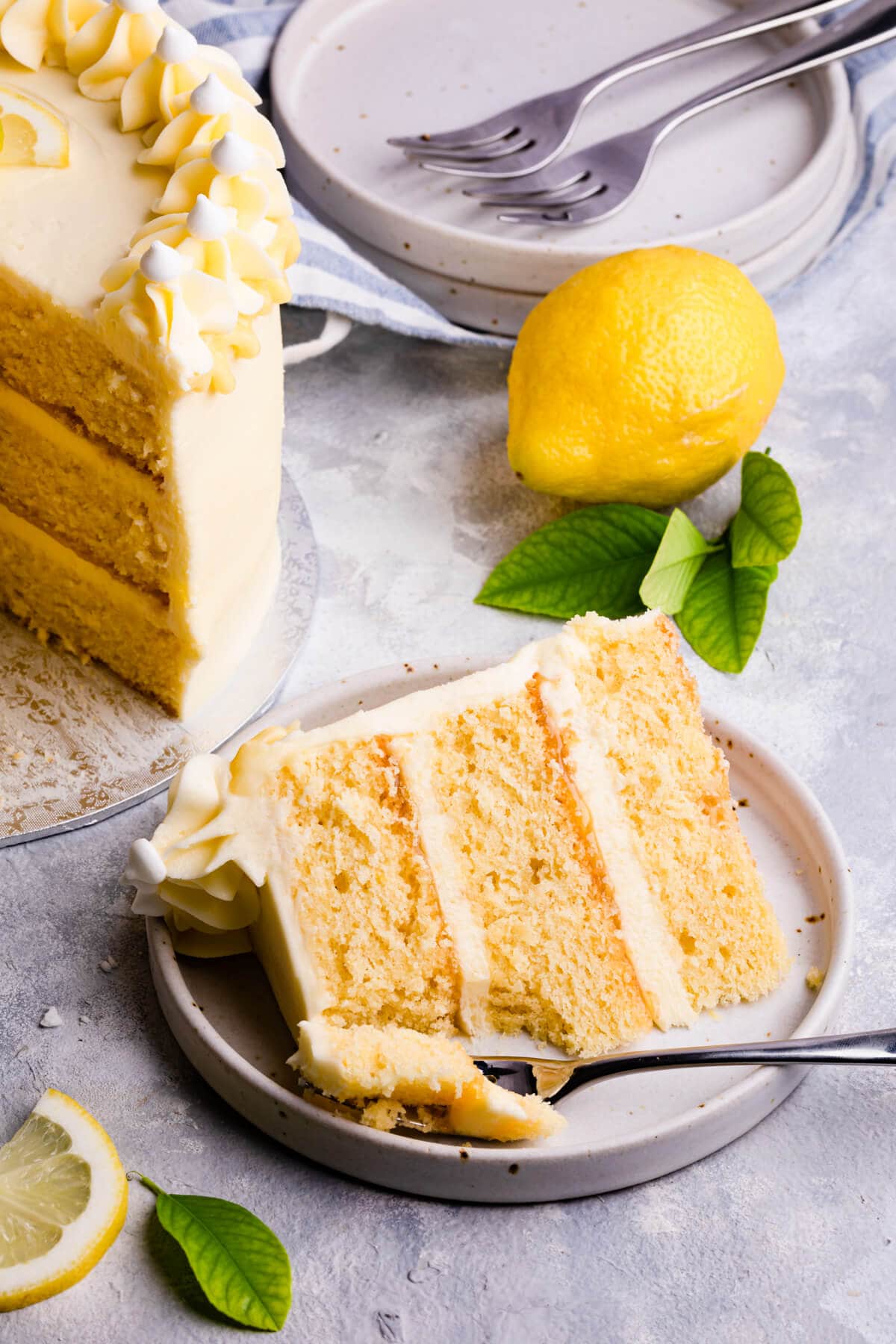
Plain sponge cakes are suitable for freezing for up to two months. Wrap each sponge in a double layer of clingfilm and thaw in the fridge overnight.
Buttercream is also suitable for freezing. Transfer it to an airtight container and freeze for up to two months. Thaw in the fridge overnight, then whip it well using a handheld electric mixer or stand mixer fitted with paddle attachment.
Hint: Make sure to bring this cake to the room temperature before serving it, otherwise it will feel quite solid. Remove it from the fridge an hour or so before you are planning serving it.

Frequently asked questions
Can I make this cake gluten-free?
Yes you can. Replace the flour with gluten-free self raising flour and add 1 teaspoon of xanthan gum to the dry ingredients.
Can I scale down this recipe?
Absolutely! You can halve the recipe for a smaller cake. If doing so, I recommend using 2 x 20cm cake tins or one deep 20cm cake tin.
Is it necessary to apply the crumb coating first?
Although it is not absolutely necessary, the crumb coating will make the process of icing the cake MUCH easier. Crumb coat will 'lock' the crumbs down, seal in the cake moisture and provide an even base for the additional frosting. It is an extra step that is definitely worth the effort!

To pin this recipe and save it for later, use the button on the recipe card, or on any of the photos above.
If you try this recipe, or any other recipe on Anna Banana, please take a moment to rate the recipe and/ or leave me a comment. I love hearing from you , but it also helps the other readers who are thinking of making the recipe.
📖 Recipe
Lemon and Elderflower Cake
Equipment
- 3 20 cm cake sandwich tins
- baking paper
- hand-held electric mixer or freestanding mixer with the paddle attachment
- 2 mixing bowls
- small saucepan
- cake board optional
- ice cream scoop or large cookie scoop optional
- cake turntable optional
- 2 Piping bags
- cake scraper
- 1 small plain nozzle 0.5cm opening will work well
- 1 decorative nozzle I used Wilton 2M
Ingredients
For the sponge:
- 450 g unsalted butter softened
- 450 g caster sugar or granulated sugar instead
- 6 medium eggs
- 100 g soured cream or natural yogurt instead
- 50 ml elderflower cordial
- 450 g self-raising flour see notes for the alternative
- 1 large lemon, zest only keep the juice for syrup
For the syrup:
- 1 large lemon, juice only
- 50 g caster sugar or granulated sugar
- 50 ml water
For the buttercream:
- 800 g icing sugar
- 400 g unsalted butter softened
- 80 ml elderflower cordial
- 100 g lemon curd
For the white chocolate ganache drip:
- 80 ml double cream
- 20 g unsalted butter
- 150 g white chocolate
Instructions
To make sponges:
- Preheat the oven to 160°C (140°C fan). Lightly grease 3 x 20cm cake sandwich tins and line the base of each with baking paper.
- Using an electric mixer, beat the softened butter and the sugar together until pale and fluffy, about 3 minutes. In a small jug, whisk together the eggs, soured cream or yoghurt and elderflower cordial.
- Add the flour to the sugar and butter mixture, mix on low speed until just combined, then add the eggs mixture and beat on medium-low speed to combine well. Lastly, add the lemon zest and mix everything together until you have smooth, thick batter.
- Divide the batter between the cake tins (you can use kitchen scales to weigh the batter and to be precise) and smooth the top of each with the back of the spoon or spatula. Bake for 35-40 minutes, until golden brown and springy to the touch.
- Remove the cakes from the oven and allow them to cool in the tins for 10 minutes. Remove from the tins and transfer to cooling rack to cool completely.
- Once the sponges have cooled completely, use a large, sharp serrated knife or a cake leveller to trim the tops and level the cakes (if needed).
To make the syrup:
- Place all of the syrup ingredients into a small saucepan over a medium heat. Allow the sugar to dissolve completely, then bring the mixture to boil for a couple of minutes. Remove the syrup from the heat and allow it to cool.
- Using a skewer or a toothpick, gently poke the sponges all over the surface. Use the pastry or silicone brush to brush the cooled syrup over each sponge (you may not necessarily need to use all of the syrup).
To make the buttercream:
- Place the softened butter into a bowl of an electric mixer and beat until pale and fluffy, about 3 minutes.
- Add the icing sugar in 3 separate additions (to avoid the sugar eruption) and beat well after each addition.
- Pour in the elderflower cordial and beat for another 3 minutes until you have smooth and fluffy buttercream. Set aside until needed.
To make the white chocolate ganache drip:
- Finely chop the white chocolate and place it in a medium heatproof bowl.
- Place the double cream and butter in a small saucepan over a small heat and cook until butter has melted, and the cream is hot but NOT BOILING. Remove from the heat.
- Slowly pour the hot cream and butter mixture over the white chocolate and leave it to stand for a couple of minutes. After a couple of minutes, stir it gently to combine until you have smooth, shiny ganache.
- Leave the ganache to cool for 10-15 minutes, allowing it to thicken. Transfer it to a piping bag fitted with small, plain nozzle (0.5cm opening will work well).
To assemble the cake:
- Spread a small amount of buttercream in the middle of the cake board sat on top of the cake turntable (if you have one), alternatively, use a large plate.
- Place the first sponge on top of the cake board/ plate and add about 3 tablespoon of buttercream on top of the sponge and spread it in an even layer. Add an even layer of lemon curd on top of the buttercream, then place the second sponge on top of it, repeating the step with buttercream and lemon curd.
- Place the third sponge on top and use the remaining buttercream to cover the sides and the top of the cake, scraping off any excess. Save any leftover buttercream and transfer it to a piping bag fitted with any decorative nozzle.
- Pipe the white chocolate ganache drip into the very edge of the cake, allowing it to drip and to set. Pipe any leftover buttercream on top of the cake. Transfer the cake into the fridge for about 30 minutes, allowing it to set. Remove from the fridge and bring to room temperature before serving.
Please note that all my recipes are developed and tested in metric grams. I recommend that you use digital scales for a more accurate results. I have provided a conversion to US customary in the recipe but please note that I haven’t tested using this method.



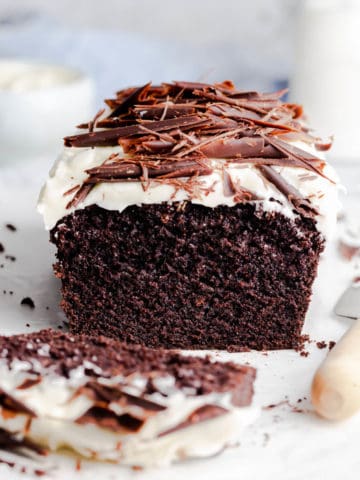
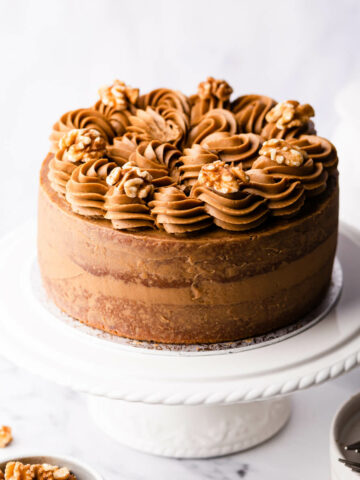

Sharon
This layer cake has so many elements of sweet flavor that come together beautifully. The perfect cake for a summer wedding or baby shower.
Heather
Such a beautiful cake! Never baked with elderflower before, so can't wait to try in this cake with lemon!
Leslie
This cake is stunning! The combination of buttercream with the lemon curd is nothing short of AMAZING!!
Freya
Mine didn’t look as fabulous as yours but it did taste stunning! The elderflower adds an undefinable something that is unique and magical!
Amanda
This is such a wonderful cake for summer! I love the bright tang the lemon curd added, and it was delicious with the elderflower.
Mikayla
I have to fall back on the typical comments.. This cake came together very nicely and the flavors were so bright and pleasing. The floral is very subtle but is also the highlight of the cake.
Anna
Thanks Mikayla, it's great to hear that you enjoyed this recipe!
sam
this recipe was delicious, made it for my daughters birthday and have been asked to make it again but as cupcakes. do you have any suggestions for this? particularly thinking of timings. thanks
Anna
Hi Sam, thank you for trying the recipe, so happy to hear that it was a success! You definitely can make it into cupcakes. I would suggest baking cupcakes for about 15-20 minutes, until they have risen and are springy to the touch. Gently poke each cupcake (after they have cooled slightly) with toothpick, then brush with syrup. Allow them to cool completely and top each cupcake with the buttercream. Hope this helps!
Dennis Littley
My sister-in-law and I made this cake together and it came out spectacularly! I wish I had taken some pictures to share with you.
thanks for a delicious recipe!!
Anna
Hi Dennis, thank you so much for this review, I'm so pleased to hear that you guys made and enjoyed this cake!
Katie
This is such a beautiful cake! I can't wait to give it a try!!
Katie xoxo
Anna
Thanks Katie, I hope you enjoyed the recipe!